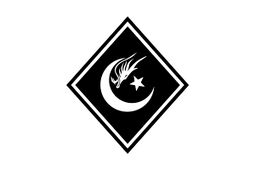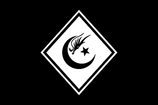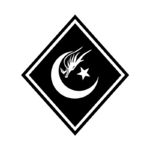Flag of Amenria: Difference between revisions
m (Fixed gallery ~Vrn) |
|||
| (14 intermediate revisions by one other user not shown) | |||
| Line 34: | Line 34: | ||
== Symbolism == | == Symbolism == | ||
The colours {{wp|black}} and {{wp|white}} could either be interpreted to signify {{wp|yin and yang}} respectively or [[R1|earth]] and [[seven heavens and judgement realms|heaven]], or the "blackness" of human nature ([[ | The colours {{wp|black}} and {{wp|white}} could either be interpreted to signify {{wp|yin and yang}} respectively or [[R1|earth]] and [[seven heavens and judgement realms|heaven]], or the "blackness" of human nature ([[Human (Realms)|humans]] are not impeccable and are able to {{wp|Islamic views on sin|sin}} and [[Adam (Realms)|were made from soil]]) and the "whiteness" or divinity of {{wp|God in Islam|God}}, {{wp|names of God in Islam|His perfection}}, and His presence within every [[Divine Spark|sentient creature]]. | ||
The outermost rhombus symbolizes the people, the middle one, the [[Ministry of Religion (Amenria)|clergy]], and the innermost one the [[Amenrian Noble Families|nobility]]. | |||
The star and crescent serve as a symbol of {{wp|Islam}}, with the dragon head representing a reverence to {{wp|Culture of Asia|local culture}}, signifying that although the country is an {{wp|Islamic state}}, it opposes {{wp|Arabization}} in favour of local customs. | The star and crescent serve as a symbol of {{wp|Islam}}, with the dragon head representing a reverence to {{wp|Culture of Asia|local culture}}, signifying that although the country is an {{wp|Islamic state}}, it opposes {{wp|Arabization}} in favour of local customs. | ||
| Line 99: | Line 101: | ||
|File:Flag of the Republic of China 1912-1928.svg | |File:Flag of the Republic of China 1912-1928.svg | ||
|Flag of the {{wp|Republic of China (1912–1949)|Republic of China}} (1912–1928), representing the {{wp|Five Races Under One Union}} principle | |Flag of the {{wp|Republic of China (1912–1949)|Republic of China}} (1912–1928), representing the {{wp|Five Races Under One Union}} principle | ||
| | |File:Flag of the Empire of China (1915–1916).svg | ||
|National flag of {{wp|Empire of China (1915–16) | |National flag of {{wp|Empire of China (1915–16) | ||
|Empire of China}} 1916 | |Empire of China}} 1916 | ||
| Line 112: | Line 114: | ||
|File:National Flag of Chinese Soviet Republic.svg | |File:National Flag of Chinese Soviet Republic.svg | ||
|Flag of the {{wp|Chinese Soviet Republic}} (1931–1937) | |Flag of the {{wp|Chinese Soviet Republic}} (1931–1937) | ||
|Flag of the Chinese Communist Party (Pre-1996).svg | |File:Flag of the Chinese Communist Party (Pre-1996).svg | ||
|Flag of the Chinese Communist Party before 1996 | |Flag of the Chinese Communist Party before 1996 | ||
|File:Second War Flag of Chinese Soviet Republic.svg | |File:Second War Flag of Chinese Soviet Republic.svg | ||
|War flag of the Chinese Workers' and Peasants' Red Army | |War flag of the Chinese Workers' and Peasants' Red Army | ||
|File:Flag of the Republic of China-Nanjing (Peace, Anti-Communism, National Construction).svg | |File:Flag of the Republic of China-Nanjing (Peace, Anti-Communism, National Construction).svg | ||
|The | |The {{wp|Flags of the Reorganized National Government of China|Flag}} of the {{wp|Reorganized National Government of the Republic of China}}, a Japanese {{wp|puppet state}} during {{wp|World War II}}, was based on the Flag of the Republic of China. | ||
|File:Flag of Manchukuo.svg | |File:Flag of Manchukuo.svg | ||
|[[Flag of Manchukuo|National flag of Manchukuo]] 1934–1945 | |[[Flag of Manchukuo|National flag of Manchukuo]] 1934–1945 | ||
|File:Flag of Russia.svg | |File:Flag of Russia.svg | ||
| | |{{wp|Flag of Russia|Russian flag}} used in {{wp|Russian Dalian|Dalian}} (1895–1905) | ||
|File:Flag of the Soviet Union (1936–1955).svg | |File:Flag of the Soviet Union (1936–1955).svg | ||
| | |{{wp|Flag of the Soviet Union|Soviet flag}} used in {{wp|Dalian}}, {{wp|Chinese Eastern Railway}} and {{wp|Soviet occupation of Manchuria|its occupation of Manchuria}} (1945–1946) | ||
|File:Flag of Japan (1870–1999).svg | |File:Flag of Japan (1870–1999).svg | ||
| | |{{wp|Flag of Japan|Imperial Japanese flag}} used in {{wp|Kwantung Leased Territory}} (1905–1945), {{wp|Taiwan under Japanese rule|Taiwan}} (1895–1945) and occupied parts of southeastern China (1937–1945) | ||
|File:Flag of CER (1897).svg | |File:Flag of CER (1897).svg | ||
|Flag of the Chinese Eastern Railway used in 1897–1915 | |Flag of the Chinese Eastern Railway used in 1897–1915 | ||
| Line 158: | Line 160: | ||
|align=center | |align=center | ||
|footer= | |footer= | ||
|File:Amenria cambodia.png | |||
|{{wp|Cambodia}} | |||
|File:Amenria china.png | |||
|{{wp|China}} | |||
|File:Amenria india.png | |||
|{{wp|India}} | |||
|File:Amenria japan.png | |||
|{{wp|Japan}} | |||
|File:Amenria kazakhstan.png | |||
|{{wp|Kazakhstan}} | |||
|File:Amenria best korea.png | |File:Amenria best korea.png | ||
|{{wp|South Korea}} | |{{wp|South Korea}} | ||
|File:Amenria russia.png | |||
|{{wp|Russia}} | |||
|File:Amenria saudi.png | |File:Amenria saudi.png | ||
|{{wp|Saudi Arabia}} | |{{wp|Saudi Arabia}} | ||
|File:Amenria sri lanka.png | |||
|{{wp|Sri Lanka}} | |||
}} | |||
{{Gallery | |||
|title=Joke flags | |||
|width=140 | |||
|height=120 | |||
|align=center | |||
|footer= | |||
|File:Amenria dream.png | |||
|Dream flag | |||
}} | }} | ||
| Line 169: | Line 195: | ||
[[Category:Flags]] | [[Category:Flags]] | ||
[[Category:National flags]] | [[Category:National flags]] | ||
[[Category:Flags of Amenria]] | [[Category:Flags of Amenria]][[Category: Culture of Amenria]] | ||
Latest revision as of 22:19, 30 September 2024
This article is incomplete because it is pending further input from participants, or it is a work-in-progress by one author. Please comment on this article's talk page to share your input, comments and questions. Note: To contribute to this article, you may need to seek help from the author(s) of this page. |
 | |
| Name | 白龙旗 (English: "White Dragon Flag") |
|---|---|
| Use | National flag |
| Proportion | 3:2 |
| Adopted | 31 August 2042 |
| Design | A white star and crescent with a dragon's head within a black rhombus, contained within a white rhombus, which is then contained within a black rhombus |
 Variant flag of Amenria | |
| Name | 黑龙旗 (English: "Black Dragon Flag") |
| Use | War flag |
| Proportion | 3:2 |
| Adopted | 31 August 2042 |
| Design | A black star and crescent with a dragon's head within a white rhombus, contained within a black rhombus, which is then contained within a white rhombus |
The national Flag of Amenria, officially named the White Dragon Flag (Chinese: 白龙旗, pinyin: Bái Lóng Qí) consists of a white star and crescent with a dragon's head within a black rhombus, contained within a white rhombus, which is then contained within a black rhombus. It has been used by the empire's government since the founding of the nation in 2042. The colours and the design in general is made to be able to be interpreted in multiple ways by the observer.
Symbolism
The colours black and white could either be interpreted to signify yin and yang respectively or earth and heaven, or the "blackness" of human nature (humans are not impeccable and are able to sin and were made from soil) and the "whiteness" or divinity of God, His perfection, and His presence within every sentient creature.
The outermost rhombus symbolizes the people, the middle one, the clergy, and the innermost one the nobility.
The star and crescent serve as a symbol of Islam, with the dragon head representing a reverence to local culture, signifying that although the country is an Islamic state, it opposes Arabization in favour of local customs.
Colour scheme
Colour |
Black | White |
|---|---|---|
| CMYK | 100-61-32-96 | 0-0-0-0 |
| RGB | 0-0-0 | 255-255-255 |
| Hex | 000000 | FFFFFF |
Military flags
Aside from the war flag, which is the national flag with inverted colours, the Imperial Amenrian Armed Forces uses five flags, one for each service branch. The main feature of these flags are a depiction of one of the Four Auspicious Beasts (with the addition of the Golden Dragon being featured in the Imperial Guard flag) inside a ring, with the exception of the Azure Dragon depicted in the Imperial Police Flag, which is inside a shield instead. These flags share the same dimensions (3:2) as the national flag.
The flag of the Ground Forces consists of the White Tiger facing right in a black ring on a white background, the naval ensign consists of the Black Tortoise facing downwards in a black ring on a blue background, the Air Force depicts the Vermillion Bird in a vermillion ring on a white background, the Imperial Police features the Azure Dragon in a shield on a black background, and the Imperial Guard uses the Golden Dragon in a golden ring on a red background. The colour white on the Ground Forces flag represents metal, the element associated with the entity, virtue, and the Ground Force's emphasis on tanks. The blue in the Navy's flag is meant to represent both the sea and the element water in general, while the blue in the Imperial Police flag represents strength, patience, and altruism. The red in the Air Force Flag represents fire and the red in the Imperial Guard flag represents luck. The gold in the latter flag represents heroism and the Imperial Guard's status as an elite special forces branch.
Historical flags/Foreign-involved flags
For a more comprehensive list, see List of Chinese flags
Flag of the Qing dynasty (1862–1889)
Flag of the Qing dynasty (1889–1912)
Flag of the Republic of China (1912–1928), representing the Five Races Under One Union principle
National flag of Empire of China 1916
Flag of the Republic of China (1928–2033)
Flag of the National Revolutionary Army (1928–1947) and the flag of the Republic of China Army (1947–2033)
Flag of the Kuomintang and the naval jack of the Republic of China Navy (1947–2033)
Flag of Chinese Taipei used by ROC (1984–2033)
Flag of the Chinese Soviet Republic (1931–1937)
The Flag of the Reorganized National Government of the Republic of China, a Japanese puppet state during World War II, was based on the Flag of the Republic of China.
National flag of Manchukuo 1934–1945
Russian flag used in Dalian (1895–1905)
Soviet flag used in Dalian, Chinese Eastern Railway and its occupation of Manchuria (1945–1946)
Imperial Japanese flag used in Kwantung Leased Territory (1905–1945), Taiwan (1895–1945) and occupied parts of southeastern China (1937–1945)
Non-canon flags
Celebrating Ramadhan and Idul Fitri (2023)
Celebrating Independence Day


















